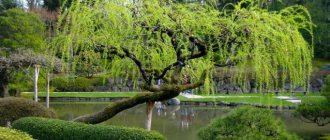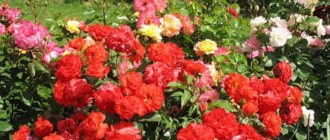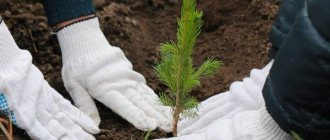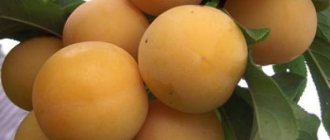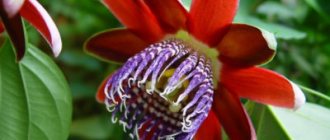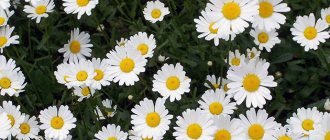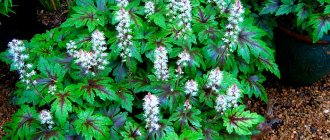Loading…
Loading…
Do you admire the candles of chestnut inflorescences, but don’t have enough free space on your property for this tree? Then grow Lakonos, planting and caring for which does not require excessive effort. Of course, this is far from a mighty chestnut, but just a tall herbaceous bush. But its flowering is really very similar to chestnut candles, and the fruits are no less original.
Lakonos is a perennial with a pronounced dormant period, and is also completely unpretentious. Before the flowers bloom, the plant is nothing special. Just think, just a tall weed. But when flowering begins, the bush immediately attracts attention, just as during the period of fruit ripening. Today we will talk about what a plant looks like and how to grow it in the garden.
Among gardeners, laccone is also known as fat grass, kermes berry and Judean ivy. In the scientific literature it is called phytolacca.
Botanical description of the plant
Lakonos is a perennial herbaceous shrub. The plant is quite large in size - the height of the stems can exceed three meters in length. Another name is American phytolacca. The decorative effect of the perennial is due to the presence of bright inflorescences that remain on the plant all summer.
The rhizome is multi-headed, has a central root and several branches spread in different directions. The roots are fleshy and taprooted. The length of the roots exceeds a meter. The weight of the rhizome of an adult plant exceeds 10 kg. Thus, the rhizome is able to nourish the plant with a sufficient amount of nutrients. The rhizome of the plant is poisonous and is therefore not used for medicinal purposes.
The stem is thick, woody, brown or burgundy in color. The stems of the plant are highly branched, making the shrub look lush. As a rule, one central stem emerges from the rhizome of the plant, from which shoots extend. The thickness of the stem reaches 5 cm. The shoots of the Lakonosa are painted in a light green shade.
Large bright green leaves grow on the stem along the entire surface of the bush. The leaf plate is smooth, with a pointed end and smooth edges. On the shoots, the foliage is located opposite each other. The shape of the leaf is ovoid, narrowed towards the end. The length of the leaf can exceed 10 cm and the width 4 cm. A network of veins is clearly visible over the entire surface of the leaves. The leaves are attached to the stem using small thickened petioles.
Blooms all summer. The flowers are bisexual, appearing in racemes of white or yellow inflorescences. Laconia flowers are small, collected in a single racemose bud, located at the tip of the shoots. The length of each flower in the inflorescence does not exceed half a centimeter. The length of the inflorescence reaches 30 cm. The plant forms simple perianths, first white, then reddening. There are 10 stamens per inflorescence with a superior ovary.
After the inflorescences fall off, in the fall, a purple fruit is formed on the bush - large berries. The fruits are round in shape and filled with seeds inside. The seeds are quite small, not exceeding 3 mm, and black in color. The fruits begin to form in August, ripening by the beginning of frost. The consumption of such berries is impossible, since the chemical composition of the fruit contains a toxic component that is dangerous to human life.
Lakonos flowering
Phytolacca inflorescences are presented in the form of small flowers with a burgundy tint. They have an arrow-shaped shape and are collected in dense brushes. At the beginning of flowering, the inflorescences are white, and a little later they change their shade to burgundy.
The crop begins to bloom in mid-summer and ends in early autumn. After flowering, dark, glossy fruits appear on the flowering plant, which are used by gardeners as seed material.
Spreading
North America is considered its natural habitat. However, you can find shrubs in the Eastern Hemisphere - in the North Caucasus, Talysh. In Russia, Lakonos grows widely as an ornamental plant. Its ease of care and ability to reproduce quickly make it possible to grow the shrub in the central part of the country. The plant is prone to going wild, therefore, when grown in the garden, phytolacca requires additional care.
Natural habitat conditions are weedy places - you can find wild shrubs on roadsides, in gardens and orchards. Arid soil, mountain slopes and coastal areas are considered favorable for the plant; it often lives in wastelands and along the edges of abandoned paths.
How to plant and grow
A particularly important point to pay attention to when planting phytolacca is soil fertility. If there are not enough nutrients in the soil, the leaves of the flower will be small and the bush will be small.
Other features that you should pay attention to when growing and caring for laccones include:
- The most favorable soil type is loamy with low acidity;
- Lighting is not important, but in a bright area the flower bears fruit earlier and more abundantly;
- When planting young seedlings, it is important to choose areas protected from drafts;
- It is recommended to plant in the spring, in pre-prepared wide and deep holes. The distance between holes must be at least two meters;
- When planting seedlings, it is important not to damage the root;
- After planting, it is important to ensure abundant and regular watering; this is not a drought-resistant plant;
- At the end of autumn, it is recommended to cut off the entire above-ground part;
- In areas with severe frosts, it is important not to forget about mulching.
Phytolacca is not a capricious plant; it is quite easy to grow. However, you should not forget about some features, such as regular watering.
Let's watch an interesting video about Phytolacca laconosa:
Types and varieties of Lakonos
More than 20 species of Laconia can be found in their natural habitat. However, growing at home has made it possible to release some hybrid varieties of Laconaceae. Depending on the variety, lakonos has its growth characteristics and characteristics.
Lakonos grape
A tall, perennial plant. The height of some individuals exceeds 2 meters. A feature of the variety is the presence of dark green foliage, ovoid in shape. The leaf blade of grape lacquer is rough to the touch. Veins stand out on the surface of the sheets.
The variety blooms in June-July. At the same time, bright pink spike-shaped inflorescences with purple or pink flowers inside are formed on the plant. The inflorescences are arrow-shaped, large, the length of the inflorescences often exceeds 25 cm. The decorative value of the inflorescences is high, since even after cutting the bouquets, the flowers remain in bloom for half a month.
After flowering, in place of the formation of flowers, fruits with seeds appear - large purple or black berries. The fruits remain on the plant for half of autumn, then fall off and throw out seeds. When grown decoratively, the bush quickly runs wild and grows, so the fruits are promptly removed from the shoots.
American Lakonos
A variety widely used in alternative medicine and decorative arts. It is a shrub whose shoots reach 3 meters in length, with the typical characteristics of a shrub. The peculiarity and main difference is the presence of light shades of foliage, as well as white inflorescences.
American laceweed has light green, pointed leaves. The surface of the leaf is smooth with a vein visible in the middle of the plate. The leaves are arranged opposite each other on dense, coal-shaped petioles.
Phytolacca blooms with white racemose inflorescences. The flowers are small and simple in shape. The length of the inflorescences reaches 25 cm; flowering occurs in mid-summer. Flowers are decorative throughout the summer
Phytolacca fruiting begins in August, when the gradual fading of the inflorescences is replaced by the formation of dark, poisonous fruits. The fruits are glossy in color and filled with small black seeds inside. Fruit ripening lasts until mid-October. After which the plant drops its berries.
Lakonos berry
Asian representative of Phytolacca. A special feature of the shrub is its dark green leaf blades with a pointed shape, which form dense thickets. In addition, the appearance of milkweed fruits is similar to blackberries.
Berry flowering plant blooms throughout the summer. The crop produces a long, spike-shaped bud, white or light pink. The inflorescences are lush and large and can retain their fresh appearance for 2 weeks after cutting. Phytolacca berry is in demand among Asians. They use the stems and foliage of the bush as food to prepare various dishes.
Edible Lakonos
A tall bush, the length of the stems exceeds 3 meters. The northern part of America is considered the natural habitat of the perennial. The shrub has rounded leaves of light green color. The leaf blades are medium-sized, usually not exceeding 8 cm in length, located oppositely on dense and succulent petioles.
Edible milkweed blooms in mid-summer. At the same time, inflorescences in the form of white or yellowish corn are formed at the tips of the shoots. Small flowers are located inside the inflorescence. Inflorescences reach 15-20 cm in length.
The fruits have a dark glossy appearance. The berries are similar in size and shape to blackberries. The fruits are located apically, in the form of a cob or spikelet. In Central Asia, cobs are used for food, preparing edible dishes from phytolacca.
Lakonos polycarpus
A low shrub, the height of which does not exceed 2 meters. The plant has elongated oval leaves, colored dark green. The peculiarity of the culture is the presence of purple inflorescences that decorate the garden throughout the summer. After flowering, no less decorative blue berries appear on the bush.
Description and characteristics of the Lakonos flower
The plant belongs to the Lakonosov family. The original name of the flower is phytolacca (Latin). Lakonos can look like a vine, tree or shrub. In the country's conditions, the most common is the American lacquer.
The leaves of the plant are ovoid in shape. They reach 6 cm in width and 20 cm in length. Drooping clusters are covered with round, smooth berries.
During the flowering period, the bush is covered with small flowers. They reach 5 mm in diameter. Flowering lasts 2 months - from July to August. Fruiting occurs in autumn. Brushes with berries look like chestnut candles.
Lakonos is known for the healing properties of its rhizome. It is a source of vitamins and elements that have a positive effect on the human body. The berries are not eaten as they are poisonous.
Lakonos planting and care in open ground
Lakonos is considered an unpretentious plant to grow. If desired, you can plant and grow ornamental bushes, even in the southern part of the continent. The plant quickly runs wild, so in garden conditions, it is worth paying enough attention to the bush. In addition, the plant requires certain periods of watering and fertilization.
An open area in the garden with an optimal amount of free space is chosen as a planting site for Laconia. Since the shrub is tall, it must be planted away from other plants that require large amounts of sunlight. This is due to the fact that the plant's foliage will prevent other crops from receiving enough sunlight.
For optimal growth and development, lakonos is planted in sunny or partial shade. In the second case, the plant rarely reaches its maximum height and bears fruit abundantly. The plant does not tolerate drafts, so it is worth planting the shrub in a fenced area, in the southern or western part of the garden. Young shrubs, which can die from the wind, are especially afraid of drafts.
Watering
Lakonos does not tolerate long-term drought, therefore, in the garden, regular watering of the bush is provided. It is important to prevent stagnation of water in the soil, since the lacquer plant also does not survive in swampy areas. It is considered optimal to water the shrubs weekly with a bucket of settled water. It is worth watering the bush during flowering, as the soil dries out.
Soil for Lakonos
As for the soil for planting Laconia, choose soil with a small amount of acidic content in the ground. The soil in the place where the crop is grown must be fertile, with a sufficient amount of nutrients. The optimal environment for phytolacca is considered to be chernozem soil or peat bog. When the soil becomes depleted, the laccone quickly loses its decorative appearance and foliage.
Transplant in summer
Mature plants do not require replanting. Only if necessary, shrubs are moved to a more fertile place. To do this, in the summer the plant is carefully dug out of the ground and, without breaking the branches and rhizomes, carefully placed in a previously prepared place. Lakonos is planted in deep holes so that the rhizome is not damaged during transplantation.
Before transplanting phytolacca, take care of the drainage layer in advance. The plant does not tolerate stagnation of moisture, so after transferring the rhizome to a new place, the soil is pressed tightly to the ground. Gardeners do not recommend replanting the lacquer plant, since the long spreading roots can easily be damaged and ruin the entire shrub.
Fertilizer
Despite their unpretentiousness in cultivation, high-quality and long-term flowering of perennials ensures optimal content of nutrients in the soil. Therefore, it is worth feeding the lacquer plant regularly with organic matter. To do this, twice a month, pour a bucket of mullein infusion under the bush. Feeding is stopped only in winter. Mature crops can do without additional feeding, but soil depletion can lead to loss of decorativeness or death of the bush.
Bloom
Most species of Lakonoss bloom in mid-summer. Flowers represent the main decorative qualities of the crop. Phytolacca blooms in lush, spike-shaped inflorescences, inside of which there are small white, pink, or lilac flowers. The plant retains its decorative qualities for two weeks after cutting.
Trimming
There is no need to trim phytolacca to create a shape; the crop grows as an even bush. It is necessary to trim the top part only in the fall, to prepare the plant for wintering. In addition, to prevent unnecessary growth, the fruits of the plant are also pruned before they ripen.
General information
Despite the fact that the crop is an inhabitant of the tropics, it grows well in the garden plots of our country. The reason that many gardeners choose it is its brightness, decorativeness and unpretentiousness, which allows the plant to be grown in our climate zone.
The culture tolerates drought, is undemanding to the soil, but at the same time has its own extraordinary flavor. The plant has long beautiful inflorescences, similar to corn cobs, on which small white or pink flowers appear.
Phytolacca is characterized by long and abundant flowering, and with the onset of autumn, dark red, shiny berries appear in place of the inflorescences, which give the crop even more uniqueness.
If you want to decorate your garden with this colorful plant, be sure to plant lacconium and it will give your garden a special charm and uniqueness.
Preparing for winter
A plant planted in the southern regions grows well even without special preparation for wintering. The roots of the lacquer plant easily survive the winter because they are deep underground. When growing in a cold climate area, it is worth preparing to cover the crop. Mulching with dry leaves or spruce branches is used to cover the rhizomes. In addition, some gardeners cover the plant with cut stems and leaves.
The shelter is removed in the spring, after the air temperature has normalized and severe frosts have been prevented. In this way, the crop will prepare for the new season and will grow freely.
Lakonos care
Phytolacca was once brought to Europe as a weed. The nature of the plant allows it to quickly settle into open ground, reproduce independently and grow without care. But in order to get not a wild, but a beautiful garden specimen for a landscape composition, in the first time after planting it is better not to deprive the Lakonos of attention.
Minimal maintenance combined with favorable site conditions:
- Regular abundant watering at the root. The plant does not like drought. Especially the American variety.
- Complete pruning of above-ground greenery in late autumn.
- Mulching in regions with severe winter frosts. Use dry leaves, peat and similar covering at least 10 cm thick. Such care will help preserve the renewal buds on the roots.
The plant needs to be covered for the winter
- Periodic weeding has a good effect on the speed of plant development. Better - a day after watering.
Advice. If the plant variety is tall, supports will be installed in place.
Methods of propagation of Lakonos
If necessary, you can propagate the lacquer plant by seed division or by dividing the bush. In the first case, the shrub often reproduces by self-sowing. In addition, you can buy seeds at any store. Dividing a bush is used mainly when it is necessary to obtain 1 or 2 bushes.
Sowing Lakonoss seeds
Seeds for planting can be purchased at the store. However, this method often does not produce results, since the seed material has a short shelf life. It is better to collect fresh, ripened seeds from an adult during their ripening period.
Sowing is carried out in the fall, before the appearance of frost. The seeds are carefully distributed over the surface of the bed, in nutritious soil. After sowing, no digging is required. The first seedlings appear, as a rule, in the spring, after the end of frost. After the seedlings appear, the young bushes are carefully removed from the soil and planted in their permanent habitat. Planting in this way produces shoots and the first fruits already in the first year after planting.
Dividing the rhizome
The division of the bush is carried out in the spring, after the onset of constant warmth. An adult plant is carefully removed from the soil. It is important that the mother plant is no more than 5 years old. The division of the rhizome is done carefully so as not to break off or damage the central root. After separation, the resulting crops are immediately planted in a permanent place of growth.
Self-seeding
In its natural environment, lacquoise reproduces by self-sowing. Thus, the plant quickly grows and runs wild. In garden conditions, self-seeding is also possible. Therefore, to prevent the production of unnecessary individuals, after flowering, shoots with fruits are pruned.
Features of growing crops
Lakonos, like other plants, has its own growing characteristics.
What should you consider before planting?
Before planting seeds in spring, they must undergo a stratification procedure. For this you can use any known method. Seeds are stratified within 3 weeks. After this, the seeds are placed on a damp cloth for 2-3 days.
There is no point in the disinfection procedure. The material can be treated with growth stimulants. This will make the seeds sprout even faster.
Location and soil
Lakonos is afraid of direct sunlight, but it needs a lot of light. The best place for planting is an area with slight shade, reliably protected from the cold wind. Phytolacca has a powerful root system and can reach a height of 2 m. Therefore, it is not recommended to plant any plants nearby, as they will not survive.
See also
When to prune irises after flowering for the winter, timing and rulesRead
Lakonos grows well in secluded places. It is planted near fruit trees and shrubs. Flowers tend to repel harmful insects.
Lakonos is unpretentious to the soil and is able to adapt to any place allocated for it. Prefers slightly acidic chernozems with a loose structure. Grows on loams, as well as areas with a high content of sand and peat. A prerequisite for the soil is good drainage and high humidity.
Landing
Seed material is sown in open soil in early spring or before winter. They are sprinkled with soil and watered regularly until young shoots appear on the surface of the soil. In beds with sprouts, weeds are removed so that the crop can develop quietly. After planting, 1.5 to 2 years pass, and the first flowers appear on the laced plant.
Medicinal and beneficial properties
Lakonos has a lot of useful properties. Raw materials based on the shrub are used in alternative medicine as a remedy with a healing effect that can not only relieve inflammation, but also prevent the development of joint diseases. In addition, Lakonos is widely used in alternative medicine as a remedy that has a diuretic, laxative and expectorant effect.
The benefits are due to the content of vitamins and minerals in the chemical composition of the culture. Thus, it has been proven that the composition of the stem and leaves of phytolacca includes:
- Nicotinic acid, thiamine and ascorbic acid;
- Essential oils and microelements necessary to normalize intestinal microflora;
- Sucrose and fatty acids;
- Formic acid and flavonoids.
Thus, the use of products containing laconosa allows not only to saturate the body with useful substances, but also to strengthen the immune system and normalize metabolism.
Diseases and pests
Phytolacca almost certainly have diseases and pests in their native places. There are no plants without pests. But in Russian conditions, lacquerids have no natural enemies. Which contributes to their aggressiveness. Moreover, phytolaccas are able to repel “European” pests. Often these perennials are planted around the trunks of fruit trees.
In the Russian climate, plants are also disease-free. This resilience makes Phytolacca a tempting plant for those who don't want to spend time maintaining a garden. But the “lazy ones” will have to fight the young shoots of laccones.
Medicinal use
In some countries of Europe and Asia, lakonos is included in the composition of medicinal raw materials used in traditional medicine. The plant is part of medicines that have antiemetic and laxative effects. In addition, the shrub is often added to the components of ointments and creams used to treat skin rashes. Lakonos is the main component of such drugs as Anginol and Akofit. The first medicine helps cure various types of sore throat, the second is aimed at combating radiculitis of various localizations.
The culture is widely used in alternative medicine. Based on the culture, infusions and decoctions, alcohol and water tinctures are made. The drugs are used to eliminate inflammation, to heal wounds, as medicinal raw materials for the treatment of throat diseases, and in homeopathy.
Medicinal properties and uses of Lakonos
You can use phytolacca products for many ailments, inflammation, stomach disorders, and decreased immunity. But most often, lakonos is brewed and drunk or used externally for several diseases.
The plant can be used to treat skin and joint ailments
For hemorrhoids
A medicinal ointment based on the roots of the plant is a good remedy for hemorrhoids. They do it as follows:
- the roots of the plant are dried and then ground into a homogeneous powder;
- a small portion of the powder is combined with a fat base in a ratio of 1 to 10; you can use pork fat, Vaseline or butter;
- The product is thoroughly stirred until smooth.
The ointment is applied to a cotton swab or a piece of gauze and applied to the anus for about 20 minutes. The procedure is repeated daily, 2 times a day until the symptoms disappear.
For the spine and joints
For arthritis, osteochondrosis and arthrosis, it is useful to make therapeutic compresses. The procedure looks like this:
- a small bandage folded several times is moistened in the tincture on the roots and leaves of the plant;
- apply a compress to the sore spot;
- fix with a thick cloth on top and hold for about 2 hours.
It is best to carry out the procedure in the evening in order to immediately give the joints a rest. The beneficial properties of the plant will relieve pain and swelling, thereby improving joint mobility.
For skin diseases
For dermatitis, eczema, lichen, boils and other skin diseases, an ointment based on the leaves helps well. They do it like this:
- the leaves are dried and finely chopped;
- mix the raw materials with 2 tablespoons of pre-melted butter;
- Apply to the affected area morning and evening.
The ointment disinfects the skin area, has a calming effect, relieves inflammation and helps restore the epidermis.
Phytolacca helps well with furunculosis, lichen and dermatitis
For boils, it is also recommended to simply apply fresh leaves to the inflamed areas. You need to keep them for about 20 minutes every two hours. If desired, the leaves can be crushed into a pulp, then the juice will be released from them, and the compress will become even more effective.
For diseases of the throat and oral cavity
For sore throat, stomatitis, inflammation of the gums and other ailments, Lakonos is taken orally and used for rinsing. The properties of an alcohol tincture of crushed roots help best; 2 large spoons of dry powder are poured into 150 ml of alcohol and left for 20 days.
To treat sore throat and other inflammations, the tincture is taken orally, just 10 drops three times a day. To rinse, take 1 large spoon of the product and dilute it in a glass of water.
Attention! You need to use Lakonosa tincture for internal use and rinsing strictly in the indicated dosages so as not to cause unnecessary harm to the body.
Recipes for Lakonosa-based products
Berries and rhizomes are used as the main medicinal raw materials for Lakonos. Decoctions and tinctures are made from these components, which are then used as medicines.
Lakonosa decoction for constipation
You can solve the problem of constipation with the help of a decoction of Laconia. The leaves and roots of the plant are used as medicinal raw materials. To make one serving you will need a teaspoon of dry herb mixture.
To obtain a decoction, pour a teaspoon of raw material with half a liter of hot water and keep on fire for 5 minutes. The resulting mixture is infused for an hour and then filtered through cheesecloth. Take a tablespoon of decoction before meals, 3 times a day. the course of treatment is 5 days.
Drinking the decoction is also good for eliminating lung diseases and colds. In addition, this decoction has a good diuretic effect, which is why it is used in the treatment of edema and pathologies of the genitourinary system.
Tincture for joint inflammation
You can relieve pain and inflammation in the joints with the help of lacquer tincture. Phytolacca leaves are used as medicinal raw materials. To obtain a medicinal mixture, add half a liter of warm water to a tablespoon of dry crushed leaves of the plant. The resulting composition is mixed well and placed in a dark place with a cool climate for two weeks. Periodically, the resulting mixture is shaken.
The prepared mixture is used to rub sore joints. In addition, it is possible to use the tincture as compresses.
Tincture of phytolacca roots for the treatment of sore throat and laryngitis
To obtain a mixture from the roots of the culture, the dry mixture is finely ground in a blender. Take half a tablespoon from the resulting mixture and add it to half a cup of alcohol. The finished mixture is kept in a dark place for 2 weeks, and then taken 4 times a day, 20 drops. This tincture not only has a beneficial effect on the treatment of throat pathologies, but also strengthens the immune system.
Ointment based on phytolacca roots
To obtain an ointment from phytolacca, use 2 ml of an alcohol tincture of the culture. The tincture is mixed with a tablespoon of fat and mixed thoroughly. Some people use lanolin instead of fat. The ointment is used externally, applied to problem areas 3 times a day.
In homeopathy
Some homeopaths claim that lakonos is able to prevent and treat various oncological diseases. In addition, lakonos has a positive effect in the treatment of diseases of the female reproductive system - fibroids, fibroids and breast cancer. It has been proven that the use of lakonos helps fight pathologies such as migraines, fever, and cervical erosion. Based on the plant, vaginal suppositories are made that can relieve inflammation of the genital tract, as well as suppositories for the treatment of prostatitis in men.
In other areas
The use of phytolacca is due to its pronounced chemical composition. However, against the background of high medicinal effectiveness, phytolacca is also used in economic activities. Thus, the plant is a melliferous plant, therefore it is often used in beekeeping. Based on the nectar contained in the bush, tasty and aromatic honey is obtained.
The juice contained in milkweed berries is used to dye silk and woolen products. In addition, the fruits of the plant are sometimes added to canned foods to give them an unusual appearance.
The main use of garden lacconium is decorative. Flowers are collected into lush, long-standing bouquets that decorate the interior.
Benefits for joints and spine
In folk medicine, the shoots and roots of Laconia are often used to create a tincture intended for the treatment of arthritis, arthrosis and osteochondrosis. Rubbing it can significantly improve blood flow in sore joints, ensure a good flow of nutrients to their tissues, and eliminate discomfort.
For the same purpose, you can prepare special ointments. In terms of their action, they will be no worse than “Merifit” and “Akovita”, which were produced back in Soviet times. To create, you need to melt 1 tbsp. a spoonful of butter, mix with the same amount of lakonosa infusion, cool and put in a cool place (you can put it in the refrigerator). Store for no more than 7 days. Rub in 2-3 times per day.
Use of lacquerberry berries, recipes
Lacony berries are used not only in medical activities. Some types of phytolacca can be used as nutrients and spices. It is important to understand that the berries of the plant contain poison. Therefore, only a few types of plants can be used in cooking, after careful and proper processing.
Laconia berry or edible plant is used as a medicinal raw material. The berries of this plant contain a small amount of dangerous poison, so they do not have a toxic effect. In addition, this variety also contains tasty, nutritious leaves.
It must be remembered that using the culture in the wrong dosage can lead to acute poisoning. Therefore, you should not use the plant in home medicine without consulting a doctor.
Restrictions on the use of medicines based on Lakonosa
Despite its beneficial properties, phytolacca is considered a poisonous plant that can harm humans. In addition, it is important to understand that in some cases it is worth refraining from using herbal medicines.
Thus, pregnant women and nursing mothers are prohibited from using decoctions and infusions based on phytolacca. This is due to the fact that the plant, if used incorrectly during pregnancy, can cause miscarriage.
The restriction on the use of Lakonos is the age of under 18 years. It is necessary to avoid using culture-based products if you are allergic to the plant. Before using the plant on local areas, it is worth doing an allergy test - before using the compress, you need to check the manifestations on a small area of the skin.
Phytolacca: plant propagation
There are two options for propagating lacquerella: seed and division of the bush. Seeds can be purchased at a specialized retail outlet or obtained independently. In the first case, trust trusted manufacturers. Check the integrity of the pack and the date of preparation.
Attention! The plant also reproduces well by self-sowing. Moreover, birds can spread seeds over quite long distances.
Only a young specimen, up to 5 years old, is suitable for vegetative propagation. You simply cannot divide older plants - their roots are too heavy, deep and massive. In the spring, dig up a bush and carefully divide the rhizome into parts. Place the seats taking into account the required distance.
Collection, preparation and storage of lacquer grass raw materials
Since berries and fruits have great medicinal value, raw materials are harvested during the period of active growth and fruiting of the crop. The roots are harvested in the fall. At the same time, the raw materials are carefully dug out of the soil and thoroughly washed in running water. After this, the roots are laid out in an even layer in a dryer or oven and dried until the moisture completely disappears from the plant. The temperature during drying should not exceed 50 degrees. The fruits are dried in the same way.
Leaf harvesting can take place during the active growth of the crop - the entire growing season. To do this, the foliage is dried in dark, well-ventilated places. The resulting compositions can be mixed. Store dry lacquer in a dry, dark place. The maximum shelf life of dry raw materials is one year.
How is Lakonoss used in homeopathy?
The medicinal properties of the plant have also been noted in homeopathy. Thus, the popular homeopathic remedy “Phytolacca” is made from fresh raw materials and is recommended for pharyngitis, fever, rheumatism, sore throat, and migraines.
The effect of homeopathic preparations based on Lakonosa stabilizes the functioning of the musculoskeletal and lymphatic systems. In addition, medications have a general calming and strengthening effect on the body.
Complications
If Lakonos is used incorrectly, a person may experience the development of various complications. The poison contained in the components of medicinal raw materials can cause side effects such as:
- paralysis;
- symptoms of poisoning;
- bowel dysfunction;
- dizziness;
- nausea;
- coldness in the legs and arms.
Therefore, if you have any concerns, you can use Lakonos only after consulting your doctor. Under no circumstances should you exaggerate the generally accepted dosage of the drug, as this can lead to the development of serious consequences.
Rules for the use of Lakonos for medicinal purposes
Even the garden laccone remains a plant with weak toxic properties. When using it, it is especially important to follow a number of rules, namely:
- strictly follow the instructions and dosages specified in the medicinal prescriptions;
- do not use lacconaceous products during pregnancy and breastfeeding;
- do not treat children and adolescents under 18 years of age with phytolacca;
- Do not use phytolacca internally or externally for a long time, more than 7 days in a row.
When using infusions, ointments or tinctures for the first time externally, it is recommended to conduct a test - apply the remedy to the delicate skin at the elbow and wait. If skin irritation does not appear within a couple of hours, you can continue to use the product.
The plant is prohibited for pregnant women and children under 18 years of age.
Attention! If you are intolerant to lakonos or overdose, side effects may occur. They are usually expressed by nausea, diarrhea, headache, sweating and coldness in the extremities.

